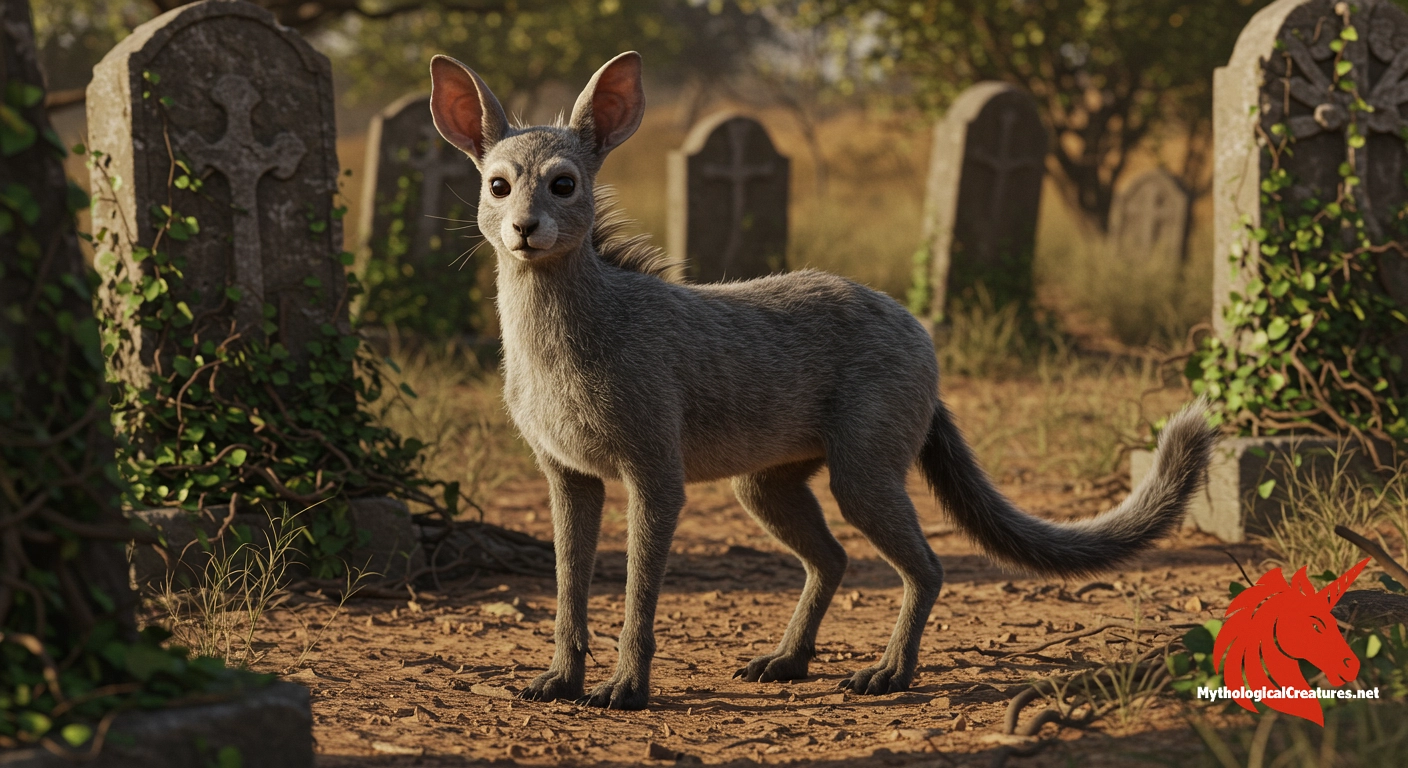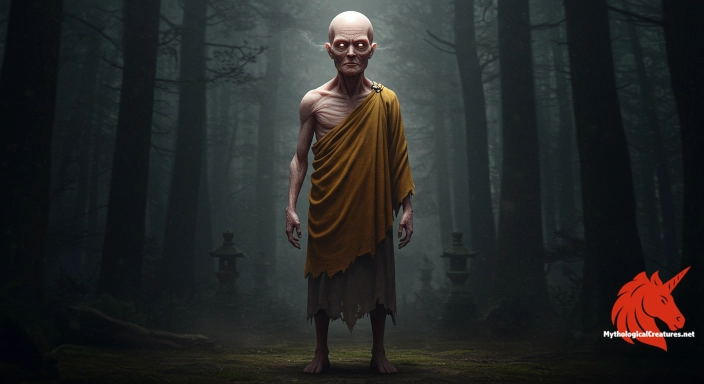Rompo: The Rompo is a mythological hybrid beast from Indian and African folklore, known for its composite features including a hare's head and human-like ears.

Rompo
Rompo - Rompo serves as a cautionary figure highlighting grave desecration and the unnatural consumption of human remains in folklore.
Origins & First Encounters
The legend of the Rompo speaks of an enigmatic creature whose origins stretch back into the shadowy recesses of India and Africa. Its myth is imbued with a sense of mystery and foreboding, capturing the human imagination through generations of oral tradition. The creature is often remembered for its unsettling title of 'Man-Eater', a name that reflects its macabre dining habits. It is depicted as a hybrid beast, composed of features that seem to defy natural order, and its story is woven into the tapestry of local superstitions and cultural fears. Over time, the narrative has evolved to symbolise the profound mysteries surrounding life and death, casting the Rompo as a liminal being that straddles the boundary between the natural and the supernatural. It occupies a unique space in folklore, where the terror of necrophagy is both a reminder of mortality and an allegory for nature’s relentless cycle of decay. As communities recounted its appearance during times of strife or unexplained misfortune, the creature came to embody deep-seated anxieties about the unknown. Its persistent presence in myth underscores the power of storytelling to translate natural phenomena into vivid, cautionary legends. The Rompo remains an enduring symbol of the darker impulses lurking at the edges of human understanding.
Source Texts & Tale Variants
The Rompo’s tale is primarily preserved in the vibrant tapestry of oral traditions, where elders and storytellers imbue the creature with an almost tangible presence. While scant direct references exist in ancient manuscripts, fragments of its myth are found intermingled with local religious and cultural narratives in both India and Africa. In various rural communities, the creature is recounted in stories that warn listeners of the dangers lurking around graveyards and abandoned sites. Travellers and colonial chroniclers occasionally recorded encounters with mysterious beasts, further enriching the lore that surrounds the Rompo. In some regions, temple carvings and local inscriptions hint at rituals intended to appease or repel the creature’s sinister influence. The multitude of narrative variants highlights how the Rompo was adapted to suit different cultural and environmental contexts. Some tellers emphasise its hesitancy and almost ritualistic circling of a discovered body, a detail that sparks both fascination and dread. Other versions portray it as a more aggressive spirit, one that actively hunts the living by preying on their dead. These story variants form a mosaic of belief that, together, illustrate the creature’s multifaceted role in the cultural consciousness. Each retelling reinforces the idea that the Rompo is as much a symbol of nature’s untamed unpredictability as it is a literal predator.
Form & Powers
The Rompo is described with an arresting array of physical characteristics that defy conventional classification. Its head and mouth bear a striking resemblance to that of a hare, lending it an appearance that is both delicate and eerily incongruous. In a twist of the familiar, its ears are said to mirror those of a human, further blurring the boundaries between animal and man. A flowing mane cascades along its slender, three-foot-long body, infusing the creature with a haunting elegance. Perhaps its most distinctive feature is its long tail, which ends in a dense, hairy brush that seems to animate with its every movement. The front feet, modeled after the digging prowess of a badger, suggest an ability to unearth hidden secrets from beneath the earth. In contrast, its hind feet, described as bearing the imposing strength of a bear, contribute to a sense of grounded, formidable power. Variations in its size and form are noted across different regions, with some accounts depicting a slightly larger and more robust version of the beast. The synthesis of these diverse anatomical traits creates an image of a creature as mesmerizing as it is repellent. Every detail of its physical composition seems carefully designed to evoke a mixture of awe, fear, and a profound sense of the uncanny.
Regional Faces
The portrayal of the Rompo shifts intriguingly from one cultural region to another, reflecting the unique spiritual landscape of each society. In some parts of India, the Rompo is envisioned as a spectral entity, a nearly ethereal presence that haunts secluded graveyards under the light of a full moon. Local narratives in these areas often place an emphasis on the creature’s mysterious, almost ghost-like qualities, imbuing it with a sense of tragic inevitability. In stark contrast, African traditions tend to depict the Rompo as a tangible force of predation, a creature whose corporeal form is as formidable as its fearsome reputation. Among these narratives, subtle embellishments such as the glow of its eyes or specific markings on its body underscore the beast’s dangerous allure. Variants of the myth incorporate elements of regional wildlife lore, suggesting that the creature might have been a personification of natural decay observed in the local ecosystem. In some communities the Rompo’s presence is intertwined with ritual practices meant to avert misfortune, reflecting a deep cultural unease with death. The local adaptations of its story bring forth a rich diversity in how the creature is perceived, from a symbolic harbinger of transformation to a literal threat demanding appeasement. These regional interpretations reveal how folklore evolves to mirror the values, fears, and environmental realities of a people. As a result, the Rompo exists in a delicate balance between a mythic warning and a culturally specific emblem of the unknown.
Cultural Parallels
The multifaceted nature of the Rompo invites comparison with a variety of mythological creatures that straddle the line between the natural and the supernatural. Its hybrid anatomy, combining elements from a hare, human, badger, and bear, echoes the chimeric figures of ancient Greek and Middle Eastern lore. In many cultural traditions, the concept of a beast that defies simple classification is a recurring motif, and the Rompo shares similarities with these diverse mythic hybrids. Like the werewolf legends of Europe or the shape-shifting tricksters of African folklore, the Rompo encapsulates the unpredictability of the natural world intersecting with the realm of the uncanny. Its macabre habit of feasting on human corpses finds a parallel in other cautionary tales that warn against the desecration of the dead. This thematic element, which often symbolises the transgression of sacred boundaries, is a familiar narrative thread in many cultural mythologies. The creature reflects the universal fear of death and decay, much like the grim reapers and other personifications of mortality found throughout global traditions. Yet, the Rompo’s distinctive ritual of circumnavigating its prey also sets it apart, suggesting an almost ritualistic reverence for the fallen. Comparative studies of mythical bestiaries reveal that such hybrid creatures are often employed to symbolise the unpredictable confluence of life, death, and nature’s relentless cycles. Through this lens, the Rompo emerges as a fascinating study in how different cultures channel their existential concerns into myth.
Legacy & Modern Evolution
The transformation of the Rompo’s image over time attests to the enduring power of myth to adapt to changing cultural contexts. Initially emerging from local oral traditions as a terrifying and enigmatic presence, the creature has, over the centuries, undergone significant reinterpretation. Early representations, anchored in the tangible fears surrounding grave desecration and the mysteries of death, gradually gave way to more symbolic and allegorical depictions. In the colonial era, as external observers encountered these local myths, the creature’s image was further exoticised and amplified in both descriptive detail and narrative intrigue. In modern times, the Rompo has found a renewed presence in literature, art, and digital media, where its hybrid form and grim habits are reimagined for contemporary audiences. Current depictions often present the beast as a metaphor, tapping into broader themes of ecological decay, cultural hybridity, and the unforeseen consequences of human progress. Artists and writers now explore its ambiguous nature, drawing parallels between the myth and modern societal fears. The shifting portrayal of the Rompo—from a literal monster to a symbol of nature’s indomitable cycle—reflects the evolving interplay between myth and modernity. This lasting legacy illustrates how an ancient legend can continue to resonate and inspire reinterpretation across time and geography. In its modern guise, the Rompo not only terrifies but also encourages a deeper reflection on the persistent mysteries of life and death.
Interesting Fact
Despite its menacing reputation, Rompo exhibits an unusual tendency to circle its found prey several times before consuming it, hinting at a complex psychological or ritualistic behavior.
Quick Creature Info
Features:
Our Mythic Legendary Rating:

Also Sometimes Known As:
Habitat:
Supernatural Powers:
Physical Attributes:
Abilities:
Behavior:
Weaknesses:
Lore:
Related Creatures, Tales or Lore
References
Discover Another Mythical Legend You May Not Have Heard Of?
Uncover the mysteries of ancient folklore and expand your knowledge of legendary beings from cultures around the world.
Dare to Meet the Ōnyūdō....
Curated by the Mythological Creatures Team (rev. May 2025)
